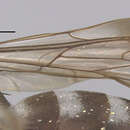Distribution
provided by Catalog of Hymenoptera in America North of Mexico
Tex. to Kans., Mo., and N. J.; Mexico (Tamaulipas).
- bibliographic citation
- Catalog of Hymenoptera in America North of Mexico. 1979. Prepared cooperatively by specialists on the various groups of Hymenoptera under the direction of Karl V. Krombein and Paul D. Hurd, Jr., Smithsonian Institution, and David R. Smith and B. D. Burks, Systematic Entomology Laboratory, Insect Identification and Beneficial Insect Introduction Institute. Science and Education Administration, United States Department of Agriculture.
Comprehensive Description
provided by Memoirs of the American Entomological Society
Anoplius (Anopliodes) bolli Banks
Anoplius bolli Banks, 1917, Bull. Mus. Comp. Zool., 61: 104 [Type: $, Texas:
Dallas (Boll) (MCZ, no. 10, 017)]. Anopliodes modestus Banks, 1939, Canad. Ent., 71: 226 [Type: 9, Texas:
Brownsville, 11-16 June 1933 (Darlington) (MCZ, no. 23, 476)].
Synonymy by Evans, 1951. Anoplius {Anopliodes) bolli Evans, 1951, Trans. Amer. Ent. Soc, 76: 238.
Female. — Length 13-19 mm. Black; pubescence wholly dark; wings
moderately to heavily infuscated, fore wing often slightly darker along outer margin. Apical margin of clypeus slightly concave; front narrow, MID .50.53 X TFD; UID .70-.80 X LID; POL and OOL subequal. Pronotum broadly but quite distinctly angulate behind. Propodeum short, its declivity well-defined, oblique, nearly flat; sides of propodeum with a few very short, inconspicuous setae. Front basitarsus with three comb-spines, occasionally a weak fourth one. SMC2 narrowed by .4-.6 above.
Male. — Length 10-13 mm. Black, pronotum narrowly margined with whitish or yellowish behind, scape sometimes with pale markings; wings subhyaline, apical margins distinctly, rather broadly, infuscated. Pubescence in considerable part dark, but silvery as follows: base of mandibles, clypeus, lower front, temples, coxae, pronotum in large part, posterior part of mesoscutum, sides of scutellum, metanotum, posterior part of propodeum, parts of the pleura, coxae, basal bands on T 1-3, and apical spots or bands on T4-7. S2 and 3 with a few weak hairs; S4 with a dense brush of hairs, longer in front than behind; S5 and 6 somewhat hirsute. SGP strongly elevated medially, the apex rounded. Genitalia characterized by having the parameres very broad near the base, the broadened area clothed with short setae, beyond this with strong setae, some of which are clubbed; digitus rather slender, clothed with short, straight setae (see fig. 78 in Evans, 1951).
Distribution. — This species is not uncommon in eastern Texas, and ranges south into Tamaulipas and north and east to Kansas, New Jersey, and Florida. (Map 43.)
Mexican specimens examined. — 1 2 . Tamaulipas: 1 2,15 mi. W Xicohtencatl, 13 Aug. 1959 (LS & AM) [UCD].
- bibliographic citation
- Evans, H.E. 1966. A Revision of the Mexican and Central American Spider Wasps of the Subfamily Pompilinae (Hymenoptera: Pompilidae). Memoirs of the American Entomological Society vol. 20. Philadelphia, USA

